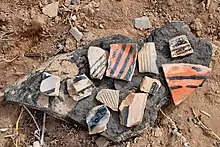potsherd
See also: pot-sherd
English
WOTD – 20 October 2018
Etymology

Potsherds from Poshuouinge, a large ancestral Pueblo ruin on U.S. Route 84, south of Abiquiú, New Mexico, USA
From Middle English pot-sherd, pot-shō̆rd,[1] pot scherd, pot scarth, from Middle English pot, pote, potte (“a container, pot, vessel; especially an earthenware vessel”) (from late Old English pot, pott (“a pot”),[2] ultimately from Proto-Indo-European *budn- (“a type of vessel”)) + Middle English sherd (“piece of fired clay or broken earthenware; potsherd”) (from Old English sceard (“a shard, sherd”),[3] from Proto-Germanic *skardą (“a nick, notch”)); equivalent to pot + sherd (“shard”).
Pronunciation
- (Received Pronunciation) IPA(key): /ˈpɒt.ʃɜːd/
- (General American) IPA(key): /ˈpɑt.ʃəɹd/
- Hyphenation: pot‧sherd
Noun
potsherd (plural potsherds)
- (often archaeology) A piece of ceramic from pottery, often found on an archaeological site.
- 1632, Edward Reynoldes [i.e., Edward Reynolds], “Verse 2”, in An Explication of the Hvndreth and Tenth Psalme: […], London: Imprinted by Felix Kyngston for Robert Bostocke, […], OCLC 19880643, page 149:
- [W]ho can deny but that the rod of Gods mouth is indeed Virga virtutis, a rod of strength, an iron rod, able to deale with all humane reaſonings, as a hammer with a potſherd, which though to the hand of a man it may feele as hard as a rocke, yet is too brittle to endure the blow of an iron rod?
- 1720, [Thomas Boston], “State II, Namely, The State of Nature, or of Entire Deprivation”, in Human Nature in Its Four-fold State: […], Edinburgh: Printed by Mr. James McEuen and Company, […]; Michael Boston, editor, Human Nature in Its Fourfold State, […], new edition, Falkirk, Stirlingshire: Printed and sold by Patrick Mair, 1784, OCLC 745149065, head I (The Sinfulness of Man’s Natural State), page 85:
- Job took a potſherd to ſcrape himself, becauſe his hands were as full of boils as his body: This is the caſe of thy corrupt ſoul: not to be recovered but by Jeſus Chriſ, whoſe ſtrength was dried up like a potſherd, Pſal[ms] xxii. 15.
- 1916, E. S. Roberts; E[rnest] A[rthur] Gardner, “Criticism and Interpretation [VIII. 2. Epigraphy.]”, in Leonard Whibley, editor, A Companion to Greek Studies: Edited for the Syndics of the University Press, 3rd revised and enlarged edition, Cambridge: At the University Press, OCLC 490495921, section 737 (Definition and Scope), page 687:
- [I]n the case of pottery, it [epigraphy] is usually taken to include graffiti scratched with a sharp point, and even painted inscriptions which are made before firing as part of the design of a vase, but not written documents (ostraka), in which pot-sherds are merely used as a material to write on instead of papyrus.
- 1950, Alphonse Riesenfeld, “Megalithic Monuments and Megalithic Culture”, in The Megalithic Culture of Melanesia, Leiden: E. J. Brill, OCLC 752624402, page 115:
- Speiser, who made excavations on Vao Island found prehistoric potsherds at a depth of 10 inches, and on the surface of the ground also.
- 2012, Richard A. Freund, Digging through History: Archaeology and Religion from Atlantis to the Holocaust, Lanham, Md.: Rowman & Littlefield Publishers, →ISBN, page 18:
- I have been asked about the single most important artifact that I have seen. It is a single broken piece of pottery no bigger than a couple of inches, but its interpretation makes it one of the most significant artifacts in Jewish history. It is an inscribed potshard (a fragment of pottery) from Masada (in Israel) marked with the name "ben Yair." […] While it remains a single potshard marked in ink, it is a powerful symbol of what motivates archaeologists in the field: a simple object that signifies an entire historical event.
-
Translations
piece of ceramic from pottery
References
- “pot-shō̆rd, n.” in MED Online, Ann Arbor, Mich.: University of Michigan, 2007, retrieved 7 November 2017.
- “pot(e, n.(1)” in MED Online, Ann Arbor, Mich.: University of Michigan, 2007, retrieved 7 November 2017.
- “sherd, n.” in MED Online, Ann Arbor, Mich.: University of Michigan, 2007, retrieved 7 November 2017.
- “potsherd” in Webster’s New Collegiate Dictionary: Based on Webster’s Third New International Dictionary, 8th edition, Springfield, Mass.: G[eorge] & C[harles] Merriam, 1973 (1974 printing), →OCLC.
This article is issued from Wiktionary. The text is licensed under Creative Commons - Attribution - Sharealike. Additional terms may apply for the media files.